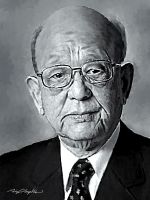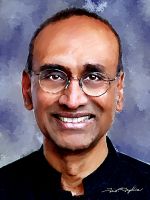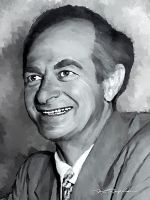
George Smith
Nobel Prize in Chemistry 2018
Nobel co-recipients: Frances H. Arnold, Sir Gregory P. Winter
Award: “for the phage display of peptides and antibodies.”

Wikipedia, Painting Tim
Tompkins PaintHistory.com
Aziz Sancar
Nobel Prize in Chemistry 2015
Nobel co-recipients: Tomas Lindahl, Paul Modrich
Award: “for mechanistic studies of DNA repair.”

Painting Tim Tompkins –
PaintHistory.com
Robert J. Lefkowitz MD
Nobel Prize in Chemistry 2012
National Medal of Science – Biological Sciences 2007 USA
Nobel co-recipient Brian K. Kobilka
Physician- Cardiologist, Scientist. G-protein-coupled receptors;
approximately half of all medicines used today use this kind of receptor.
“Strong family history of coronary artery disease … at age 50 I had quadruple bypass surgery [1994]. I minimize my risk factors with daily physical exercise, a vegetarian diet and appropriate medications”.

Wikipedia. Painting
Tim Tompkins
PaintHistory.com

Wikipedia. Painting Tim Tompkins
PaintHistory.com
Richard F. Heck Ph.D.
The Nobel Prize in Chemistry 2010
Nobel co-recipients: Ei-ichi Negishi, Akira Suzuki
Physical organic chemist. Palladium-catalyzed cross-coupling reaction. Sole author – 7 consecutive papers. Heck reaction: important concept, tool for organic and medicinal chemists; fuorescence labeling of DNA bases – sequencing DNA/Genome. Thinner computer screens in future. “Great art in test tube.”
Growing orchids in early teens lead to passion for chemistry.

nobelprize.org. Painting
Tim Tompkins –
PaintHistory.com
Ei-ichi Negishi
The Nobel Prize in Chemistry 2010
Nobel Co recipients Richard F. Heck, Akira Suzuki
Organic Chemist. Inventor of organozinc variant of the palladium catalyzed cross-coupling reaction. Read voraciously including “how to …” publications. Dreamt of Nobel half century prior to being awarded prize. Upon arriving in US and discovering Nobelists visiting UPenn, realized that being awarded the Nobel could happen to anybody including himself.

nobelprize.org. Painting
Tim Tompkins –
PaintHistory.com
Akira Suzuki Ph.D.
The Nobel Prize in Chemistry 2010
Nobel Co recipients Richard F. Heck, Ei-ichi Negishi
Organic chemist. Inventor of boron version of palladium-catalyzed cross-coupling reaction. Investigated stereochemistry of hydroboration reaction. Suzuki reaction kept evolving. Became interested in organic chemistry after reading textbook.
“There were difficult and joyful periods. Memories of tough, trying experiences tend to fade with time. Now I think mainly about fun things.”

Wikipedia. Painting Tim
Tompkins PaintHistory.com
Venkatraman Ramakrishnan
The Nobel Prize in Chemistry 2009
Nobel co-recipients: Thomas A. Steitz, Ada E. Yonath
Award: “for studies of the structure and function of the ribosome.”

Wikipedia. Painting Tim Tompkins
PaintHistory.com
Ertl Gerhard
The Nobel Prize in Chemistry 2007
Award: “for his studies of chemical processes on solid surfaces.”

Wikipedia. Painting Tim
Tompkins PaintHistory.com
Roger Kornberg
The Nobel Prize in Chemistry 2006
Award: “for his studies of the molecular basis of eukaryotic transcription.”

Society, Wikipedia. Painting Tim
Tompkins PaintHistory.com
Robert Grubbs
The Nobel Prize in Chemistry 2005
Nobel co-recipients: Yves Chauvin, Richard R. Schrock
Award: “for the development of the metathesis method in organic synthesis.”

Wiki. Painting Tim Tompkins
PaintHistory.com
Kurt Wuthrich
The Nobel Prize in Chemistry 2002
Nobel co-recipients: John B. Fenn, Koichi Tanaka
Award: “for his development of nuclear magnetic resonance spectroscopy for determining the three-dimensional structure of biological macromolecules in solution.”

Wiki. Painting Tim
Tompkins PaintHistory.com
William Knowles
The Nobel Prize in Chemistry 2001
Nobel co-recipients: Ryoji Noyori, Barry Sharpless
Award: “for their work on chirally catalysed hydrogenation reactions.”

Walter Kohn
The Nobel Prize in Chemistry 1998
The National Medal of Science – Physical Sciences 1988
Award: “for his development of the density-functional theory”

at Harvard. Creator: Trvthchem
personal photo. 19 Nov 2007.
Source: Wikimedia Commons.
Elias James Corey Ph.D.
The Nobel Prize in Chemistry 1990
Organic Chemist – Interested in application of organic chemistry to human health. His groups have achieved a multitude of total syntheses of complex molecules. Originator of retrosynthetic analysis. Recognized as “Most Cited Author in Chemistry” by American Chemical Society in 2002.
“Organic chemistry was especially fascinating with its intrinsic beauty and its great relevance to human health.”

Federal Archives, Wiki.
Jean-Marie Lehn Ph.D.
The Nobel Prize in Chemistry 1987
Nobel co-recepients Donald J. Cram, Charles J. Pedersen
Chemist. Interests: Supramolecular chemistry, Self-assembly and self-organization, Constitutional dynamic chemistry; Music, Philosophy.
Founding director, ‘Chemistry, a European Journal’. Gave starting impetus to other European journals, rare manifestation of European spirit and supranationality bridging historical divides!
President, International Organization for Chemical Sciences in Development, helping chemists in developing countries.

Donald J. Cram Ph.D.
The Nobel Prize in Chemistry 1987
The President’s National Medal of Science – Chemistry 1993
Co-Nobelists: Jean-Marie Lehn, Charles J. Pedersen
Organic Chemist. Development, use of molecules with structure-specific interactions of high selectivity. Taught himself solid geometry from book, winning scholarship. High emotional intelligence.
When word “research” entered my vocabulary, it had magic ring, suggesting search for new phenomena. Chemical research became my god, and conducting it, my act of prayer.

Painting: Tim Tompkins
PaintHistory,com
Robert Merrifield Ph.D.
The Nobel Prize in Chemistry 1984
Award: “for his development of methodology for chemical synthesis on a solid matrix”

Rob, Anefo, Dutch National
Archives; Wikipedia.
Aaron Klug
The Nobel Prize in Chemistry 1982
Crystallographic electron microscopy. Biologically important nucleic acid-protein complexes’ structural elucidation. Viruses’ 3D imaging. Zinc fingers.
“Saw Rosalind Franklin’s beautiful tobacco mosaic virus’ X-ray photographs. From then on my fate was sealed.”
“Aaron could see colleagues’ strengths, weaknesses in observations; inspired them to conduct more rigorous, adventurous research.” – Richard Henderson.

Roald Hoffmann
Roald Hoffmann Ph.D.
The Nobel Prize in Chemistry 1981
The President’s National Medel of Sciences – Chemistry – 1983
Nobel co-recipient: Kenichi Fukui
Chemist, Poet, Philosopher, Writer, Chemistry Teacher Text/Television.

Painting Tim Tompkins
PaintHistory.com
Herbert C Brown Ph.D.
The Nobel Prize in Chemistry 1979
The President’s National Medal of Sciences – Physical Sciences, 1969
Nobel co-recipient Georg Wittig
Organic Chemist. Development of use of boron into important reagents in organic synthesis. School, advanced several times, graduating at 12; refused further advancement, avoiding being sister’s classmate.
Graduating, Depression years, future wife Sarah gave him gift, Stock’s ‘Hydrides of Boron and Silicon’ because cheapest chemistry book! Led to Nobel Prize!

Painting Tim Tompkins
PaintHistory.com
Georg Wittig Ph.D.
The Nobel Prize in Chemistry 1979
Nobel co-recipient Herbert C. Brown
Organic Chemist. Development of use of phosphorus into important reagents in organic synthesis. Wittig reaction. Mentored 300 graduate students, post-docs; provided close supervision for crucial experiments.
“Chemical research and mountaineering similar. To reach goal/summit, initiative, perseverance required. After hard work, great joy to be at goal/peak with its splendid panorama…”

Painting: Tim Tompkins
PaintHistory.com
Paul J. Flory Ph.D.
The Nobel Prize in Chemistry 1974
National Medal of Sciences – Physical Sciences 1974
Award: “for his fundamental achievements, both theoretical and experimental, in the physical chemistry of the macromolecules”

Stanford Moore Ph.D.
The Nobel Prize in Chemistry 1972
Co-nobelist Christian Anfinsen, William H. Stein
Award: “for their contribution to the understanding of the connection between chemical structure and catalytic activity of the active centre of the ribonuclease molecule”

PaintHistory.com
William H. Stein Ph.D.
The Nobel Prize in Chemistry 1972
Co-Nobelists Christian Anfinsen, Stanford Moore
Award: “for their contribution to the understanding of the connection between chemical structure and catalytic activity of the active centre of the ribonuclease molecule”

Lars Onsager Ph.D.
The Nobel Prize in Chemistry 1968
National Medal of Science – Physical Sciences 1968
Award: “for the discovery of the reciprocal relations bearing his name, which are fundamental for the thermodynamics of irreversible processes”

Robert S. Mulliken Ph.D.
The Nobel Prize in Chemistry 1966
Award: “for his fundamental work concerning chemical bonds and the electronic structure of molecules by the molecular orbital method”

Painting Tim Tompkins –
PaintHistory.com
Robert B. Woodward Ph.D.
The Nobel Prize in Chemistry 1965
National Medal of Science – Physical Sciences 1964
Award: “for his outstanding achievements in the art of organic synthesis”

PaintHistory.com
Vincent du Vigneaud Ph.D.
The Nobel Prize in Chemistry 1955
Award: “for his work on biochemically important sulphur compounds, especially for the first synthesis of a polypeptide hormone”

Wiki. Painting Tim Tompkins
PaintHistory.com
Linus Pauling Ph.D.
The Nobel Prize in Chemistry 1954
The Nobel Peace Prize 1962
National Medal of Sciences – Physical Sciences 1974
Award: “for his research into the nature of the chemical bond and its application to the elucidation of the structure of complex substances.”
Also awarded Nobel Peace Prize 1962. As of Sept. 2019, only four persons and two organizations have been awarded the Nobel Prize multiple times.

PaintHistory.com
Glenn T. Seaborg Ph.D.
The Nobel Prize in Chemistry 1951
National Medal of Science – Chemistry 1991
Nobel co-recipient: Edwin M. McMillan
Nuclear Chemist. Transuranium – Plutonium. Isotopes identification. Actinide concept. Atomic Bomb. Peaceful use of atomic energy. Advisor to 10 US Presidents. Swedish ancestry. Journal since age 8 yrs. Hiking.
Franck Report: “I had joined a committee of scientists who advocated the use of the atomic bomb for demonstration purposes. We hoped the enemy would see the destructive power of this weapon and immediately surrender. In June, 1945, we attempted to deliver our plan, the Franck Report, to President Truman. I don’t know if he ever saw our work…”

Painting Tim Tompkins –
PaintHistory.com
Edwin M. McMillan Ph.D.
The Nobel Prize in Chemistry 1951
National Medal of Science – Physical Sciences 1990
Nobel co-recipient: Glenn T. Seaborg
Award: “for their discoveries in the chemistry of the transuranium elements”

William F. Giauque Ph.D.
The Nobel Prize in Chemistry 1948
Award: “for his contributions in the field of chemical thermodynamics, particularly concerning the behaviour of substances at extremely low temperatures”

Tim Tompkins – PaintHistory.com
John Northrop Ph.D.
The Nobel Prize in Chemistry 1946
Co-Nobelists James B. Sumner, Wendell M. Stanley
Award: “for their preparation of enzymes and virus proteins in a pure form”

Painting Tim Tompkins
PaintHistory.com
James B. Sumner Ph.D.
The Nobel Prize in Chemistry 1946
Co-nobelists John H. Northrop, Wendell M. Stanley
Award: “for his discovery that enzymes can be crystallized”

Peter Debye Ph.D.
The Nobel Prize in Chemistry 1936
National Medal of Science – Physical Sciences 1966
Award: “for his contributions to our knowledge of molecular structure through his investigations on dipole moments and on the diffraction of X-rays and electrons in gases”

PaintHistory.com
Harold C. Urey Ph.D.
The Nobel Prize in Chemistry 1934
National Medal of Science – Physical Sciences 1964
Award: “for his discovery of heavy hydrogen”

Tim Tompkins – PaintHistory.com
Irving Langmuir Ph.D.
The Nobel Prize in Chemistry 1932
Award: “for his discoveries and investigations in surface chemistry”

Tim Tompkins – PaintHistory.com
Theodore Richards Ph.D.
The Nobel Prize in Chemistry 1914
Award: “in recognition of his accurate determinations of the atomic weight of a large number of chemical elements”

PD Painting Tim
Tompkins PaintHistory.com
Henri Moissan Doctoral degree
The Nobel Prize in Chemistry 1906
Chemist – inorganic. Isolated fluorine. Moissan’s electric furnace. Blue perchromic acid formula, crystallized chromic acid. Uncovered silicon carbide, other carbides, borides, silicides. Theorized: from molten iron crystallize carbon under pressure, obtain synthetic diamonds. Meticulous, patient. Articulate lecturer.
“Scientific research is search for truth. Only after discovery, applicability can be considered.”

Wiki. Painting Tim Tompkins
PaintHistory.com
J William Ramsay KCBE, FRS
The Nobel Prize in Chemistry 1904
Inorganic, Organic, Physical chemist. Outstanding experimentalist. Discovered inert gaseous elements in air, determined their place in periodic system. Discovered argon, helium, krypton, neon, xenon.
Molecular weights in liquid state. Stoichiometry, thermodynamics. Helium in radium emanations.
“Noblest exercise of mind within doors, and most befitting a person of quality, is study.”

Painting Tim Tompkins
PaintHistory.com
Svante Arrhenius
The Nobel Prize in Chemistry 1903
Physicist, Physical Chemist. Electrolytic theory of dissociation
“Humanity stands … before a great problem of finding new raw materials, new sources of energy that shall never become exhausted. In the meantime, we must not waste what we have,
but must leave as much as possible for coming generations.” – Arrhenius.

Wiki. Painting Tim Tompkins
PaintHistory.com
Hermann Fischer
The Nobel Prize in Chemistry 1902
Sugar, purine syntheses. Produced phenylhydrazine. Artificial sugars. Purines from caffeine.
Businessman father, “Emil too stupid to be business man; better be a student.” Sent him to study chemistry.
“Sciences aren’t abstract constructions, but result of human endeavor; they are connected with personalities and fates of dedicated researchers who developed them.”

Wiki. Painting Tim Tompkins
PaintHistory.com
Jacobus Hoff
The Nobel Prize in Chemistry 1901
Prize motivation: “in recognition of the extraordinary services he has rendered by the discovery of the laws of chemical dynamics and osmotic pressure in solutions.”